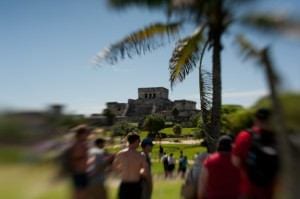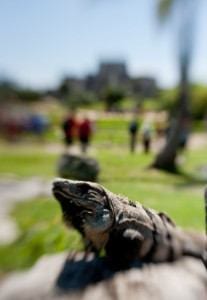Travel News
Tulum Uncovered: Beyond Mexico’s All-Inclusive Track
For independent-minded travelers who shun the all-inclusive resort, land-of-the-wristband concept of vacationing, the beaches of Tulum are the new vortex of do-it-yourself cool. Janet Fullwood gets away from the all-inclusive resort strips and discovers the laid-back vibe in the Mexican Caribbean.
Driving south on Mexico Highway 307 from Cancun to Tulum, a distance of about 80 miles, what grabs your attention most is a succession of fortress-like facades, one more grandiose than the next, arrayed against a solid green wall of jungle. Each marks the entrance to one of the large-scale, all-inclusive resorts that have come to define the new face of tourism on Mexico’s Caribbean coast.
 Self-contained and wildly popular with families and couples looking for a high-value, low-hassle vacation, all-inclusives are largely responsible for a tourism boom that brought 21,000 new hotel rooms to the Riviera Maya in the past decade and drew a record 3.6 million visitors, 80 percent of them American, to the region last year, according to the regional tourist office. But they’re hardly all there is.
Self-contained and wildly popular with families and couples looking for a high-value, low-hassle vacation, all-inclusives are largely responsible for a tourism boom that brought 21,000 new hotel rooms to the Riviera Maya in the past decade and drew a record 3.6 million visitors, 80 percent of them American, to the region last year, according to the regional tourist office. But they’re hardly all there is.
Two miles south of the much-photographed Maya ruins perched on a bluff above the sea, a strip of white sand stretches 18 miles to Sian Ka’an Biosphere Preserve, one of the largest conservations areas in Latin America. Budget travelers “discovered” the beaches of Tulum in the late 1960s, and a sprinkling of bare-bones, thatch-roof hotels with latrines down the path grew up to accommodate them. In the late 1990s a slew of foreign investors moved in, and today a miles-long stretch of boutique hotels, more than 50 in all, attract an international melange of travelers.
 The vibe here is quite unlike any other tourist zone I’ve visited in 30-plus years of travel in Mexico. An ethic of sustainability prevails, reinforced by environmental restrictions (no buildings taller than a palm tree) and limited electricity (hotels run on solar, wind or generator power). Make that stylish sustainability: For the past decade, ever since former Argentine model Nicholas Maleville and his wife, Italian designer Francesca Bonao, established their Coqui Couqi inn, restaurant and spa, the “beautiul people” of the international fashion industry have made Tulum a getaway hotspot.
The vibe here is quite unlike any other tourist zone I’ve visited in 30-plus years of travel in Mexico. An ethic of sustainability prevails, reinforced by environmental restrictions (no buildings taller than a palm tree) and limited electricity (hotels run on solar, wind or generator power). Make that stylish sustainability: For the past decade, ever since former Argentine model Nicholas Maleville and his wife, Italian designer Francesca Bonao, established their Coqui Couqi inn, restaurant and spa, the “beautiul people” of the international fashion industry have made Tulum a getaway hotspot.
Cruise the narrow beach road, drenched in the flickering shade of palm trees, and you’ll pass bikini babes on bicycles, sassy boutiques, laid-back beach clubs, open-air restaurants and an assortment of architecturally stunning lodgings incorporating palm thatch, rock and other local materials. Just in case you don’t “get” the cool factor, sign after sign advises that you have now entered “hip,” “eco-chic,” sustainable,” “charming,” “bikini boot camp,” yoga-intensive, om-inspiring, vegan catering, massage-available, shaman-on-call, New Age territory.
Thirty years ago, when I drove down in a VW Bug rented at the Cancun airport, the vibe here was one of serendipitous discovery. It still is—only now, there’s much more to discover.
This time, I’m driving the Bug’s 2012 equivalent: A stick-shift Nissan Tsuru with no clock, no radio and just one lonely hubcap. The destination is not Tulum Beach (although we’ll spend plenty of time there), but a vacation villa in a development called Tankah Tres, about six easy-driving miles up the coast.












